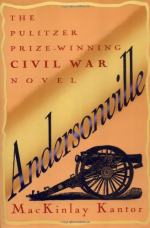But,
alas, what holy angel
Brings
the slave this glad evangel
And
what earthquake’s arm of might.
Breaks
his prison gags at night.
Said I: “Now, isn’t that fine, Berkstresser?”
He was a Democrat, of fearfully pro-slavery ideas, and he replied, sententiously:
“O, the poetry’s tolerable, but the sentiment’s damnable.”
CHAPTER XVIII.
Schemes and plans to escape—scaling the stockade—establishing the dead line—the first man killed.
The official designation of our prison was “Camp Sumpter,” but this was scarcely known outside of the Rebel documents, reports and orders. It was the same way with the prison five miles from Millen, to which we were afterward transferred. The Rebels styled it officially “Camp Lawton,” but we called it always “Millen.”
Having our huts finished, the next solicitude was about escape, and this was the burden of our thoughts, day and night. We held conferences, at which every man was required to contribute all the geographical knowledge of that section of Georgia that he might have left over from his schoolboy days, and also that gained by persistent questioning of such guards and other Rebels as he had come in contact with. When first landed in the prison we were as ignorant of our whereabouts as if we had been dropped into the center of Africa. But one of the prisoners was found to have a fragment of a school atlas, in which was an outline map of Georgia, that had Macon, Atlanta, Milledgeville, and Savannah laid down upon it. As we knew we had come southward from Macon, we felt pretty certain we were in the southwestern corner of the State. Conversations with guards and others gave us the information that the Chattahooche flowed some two score of miles to the westward, and that the Flint lay a little nearer on the east. Our map showed that these two united and flowed together into Appalachicola Bay, where, some of us remembered, a newspaper item had said that we had gunboats stationed. The creek that ran through the stockade flowed to the east, and we reasoned that if we followed its course we would be led to the Flint, down which we could float on a log or raft to the Appalachicola. This was the favorite scheme of the party with which I sided. Another party believed the most feasible plan was to go northward, and endeavor to gain the mountains, and thence get into East Tennessee.
But the main thing was to get away from the stockade; this, as the French say of all first steps, was what would cost.




